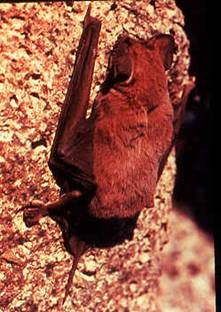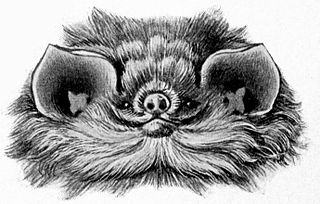
Vespertilionidae is a family of microbats, of the order Chiroptera, flying, insect-eating mammals variously described as the common, vesper, or simple nosed bats. The vespertilionid family is the most diverse and widely distributed of bat families, specialised in many forms to occupy a range of habitats and ecological circumstances, and it is frequently observed or the subject of research. The facial features of the species are often simple, as they mainly rely on vocally emitted echolocation. The tails of the species are enclosed by the lower flight membranes between the legs. Over 300 species are distributed all over the world, on every continent except Antarctica. It owes its name to the genus Vespertilio, which takes its name from a word for bat, vespertilio, derived from the Latin term vesper meaning 'evening'; they are termed "evening bats" and were once referred to as "evening birds".

The Molossidae, or free-tailed bats, are a family of bats within the order Chiroptera. The Molossidae is the fourth-largest family of bats, containing about 110 species as of 2012. They are generally quite robust, and consist of many strong-flying forms with relatively long and narrow wings with wrinkled lips shared through their genus. Their strong flying forms allows them to fly 60 miles per hour using tail winds and at altitudes over 10,000 feet. This makes them unique among bats, as they are the only bat family that withstands the elevation. They are widespread, being found on every continent except Antarctica. They are typically found in caves, abandoned mines, or tunnels.

The fringe-lipped bat is a leaf-nosed bat from southern Mexico to Bolivia and southern Brazil. It has three subspecies and no known fossils. It is the only species within its genus.

The smoky bat is a species of bat in the family Furipteridae. It is monotypic within the genus Amorphochilus. Its natural habitat is rocky shores. It is threatened by habitat loss. This bat is also called the thumbless bat because its thumb is partly enclosed in its wing; this common name is also applied to another species, Furipterus horrens. This species lives in western Peru, western Ecuador, Puna island (Ecuador) and northern Chile. These bats can be found in groups up to 300 bats. In 2013, Bat Conservation International listed this species as one of the 35 species of its worldwide priority list of conservation. The Smoky Bat is known to be exclusive to neotropical distribution, especially in Central American regions. It is also known that they do not leave their habitat until very dark out. The Smoky Bat also insectivores animals that like to fly very close to the ground to catch their prey. They also like to live in areas that are very hidden, such as small crevices (Duda, R., Dalapicolla, J., & Costa, L. P..
Bat Conservation International (BCI) is an international nongovernmental organization working to conserve bats and their habitats through conservation, education, and research efforts.

The thumbless bat is a species of insectivorous bat in the family Furipteridae, in the monotypic genus Furipterus. It is found in Costa Rica, Brazil, Venezuela; Colombia; Ecuador; Suriname; French Guiana; Guyana; Panama; Trinidad, and Peru. They have a small thumb which is included in the membrane of the wing, causing the 'thumbless' appearance.
Handbook of the Mammals of the World (HMW) is a book series from the publisher Lynx Edicions. The nine volumes were published from 2009 to 2019. Each mammal family is assessed in a full text introduction with photographs and each species has a text account with a distribution map and illustrations on a plate. This is the second major project by Lynx Edicions since the release of the Handbook of the Birds of the World in 1992. The chief editors are Russell Mittermeier and Don E. Wilson in association with Conservation International, the Texas A&M University and the IUCN. Don E. Wilson is also editor of the reference work Mammal Species of the World.





